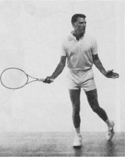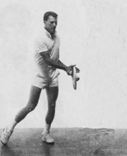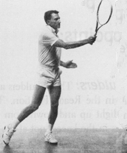TennisOne Lessons
![]()
By John Yandell
Go to Part 1 Part 2 of the Visual Tennis Series on TennisONE
(Click here to see
a complete, animated sequence of the classical style forehand.)
A respected Northern California teaching pro had a promising junior player. He was teaching her a classic technical style, with eastern grips and an all court attacking game. In one of her first tournaments she lost a match badly to a top ranked junior who played from the baseline with semi-western grips and heavy topspin.
Shortly after the match, the student's anxious father confronted the pro and demanded that the pro teach his daughter to play like the opponent who had defeated her. The pro refused. He patiently explained that in the long run a more classic, all court game was the best path for young players, and that playing too many grueling baseline matches in the juniors could lead to burn out in young players.
He also told the dad that although his daughter had ability, she was not as gifted as the player she had lost too, and that the loss had little to do with the style she was learning.
Unconvinced, the father found another pro who complied with his demands. The girl learned to play with western grips and topspin groundstrokes. Despite these changes, she never beat the player she had lost to when she was playing with the classic style. Within a year she (and her father) were discouraged with her results and she quit playing tennis altogether.
Look around at junior tournaments and you'll see that the backcourt topspin style is the rule. It may in fact be true that for most juniors, learning to grind opponents into the court with heavy spin will produce the most competitive success the most quickly. Therefore, from a limited viewpoint, such as that of the tennis father above, changing his daughter to the seemingly dominant style not only made sense, it seemed like the only choice.
Every competitive junior player dreams of winning tournaments and becoming a touring pro. Why shouldn't parents give their children the training they need to win? Isn't success in the junior an obvious prerequisite for players who dream of playing at the highest level? If most winning junior players are baseliners, why would any intelligent tennis parent want his or her child to learn a different style?
But this argument begins to fall apart when we examine its various assumptions. Sports psychologist Dr. James Loehr calculated the odds of actually becoming a touring pro. He found that the average junior player had a better chance statistically of being attacked by a great white shark than making it on the pro tour.
No child should be discouraged from his or her dreams in tennis or other areas for that matter. But just as clearly, the statistics show, decisions about how to learn the game should not be based on false assumptions about the potential of a professional career.

Look at the great players in tennis history from Tilden to Budge to Kramer to Connors, McEnroe, Lendl, Sampras, or great women's champions such as Billie Jean King, Chris Evert and Martina Navratilova. All played with some version of classical technique.
Bjorn Borg and Monica Seles are the only examples of dominant modern champions who played the heavy topspin backcourt style.
What is the Classical Style?
The strokes of all great classical players share five elements in common.
In the sequence below, taken from my book, Visual Tennis, I'm demonstrating the classical forehand stroke. While a detailed analysis of the classical style is beyond the scope of this article, you can see the essential elements--eastern grip, compact swing, racquet perpendicular to the court, use of the legs and body rotation, and finally the high follow-through. Does it look easy and uncomplicated? That's how the classical style should look--and more importantly if you are on the court--that's the way it should feel.



Full Animation of Classical Style Forehand
Click here to see a complete, animated sequence of the classical style forehand.
Teach Juniors the Classic Style
The point remains that a flatter, harder hitting classic style, a style that has widest variety of shot combinations and strategic options, can be successful at the highest levels in tennis. There is no significant correlation between the ability to grind out junior matches and eventual professional success.
One can more easily make the opposite argument: junior players who dream of playing professional tennis should learn instead to play classical style. Consistency alone is rarely sufficient for professional success. Flatter, more aggressive shot making and the ability to play a mixed strategic game is the key to winning at the highest levels.
In tennis a professional career is an enormous improbability. The real question is not: how can I teach a junior player to win and advance to the highest level the most quickly? The real question tennis players and tennis parents should ask themselves is: what style of play will allow the player to enjoy the sport more and make it an asset in his or her life?
What benefit is a slightly higher junior ranking if players risk burn out from the grinding drudgery of tournament matches? And what about tennis as an adult? How many of today's juniors will still be hitting heavy topspin and punishing opponents in long rallies at the age of 50 or 60?
The choice seems obvious in this context: learn a style that will allow you to enjoy the game the most for the longest period of time. Learn a style that will allow you to come to the net and to play doubles. Although competitive juniors rarely play doubles, doubles is a key part of high school tennis. Many high school players prefer the shared pressure and team work of doubles to the solitary pressure of singles. The grip shifts to volley with the semi-western style, as well as the size of the swings, make the transition from singles to doubles difficult and sometimes impossible for many junior players. Even players who preferred singles when they were younger often discover the joys and challenges of playing doubles as adults.
In the long run the classic style will be easier to maintain, be easier on your body, and give you the maximum number of options to play the game.
But there is a final, and probably even more persuasive argument in favor of the classical style. When properly taught it is not only infinitely more flexible, it is also far easier to learn.
No doubt tennis is challenging. But it is also generally perceived as more difficult to learn than it actually needs to be. This is where classical style has its greatest advantage.The nature of the western game with the size of the swings and the constantly changing variables of internal arm motion and wrist release put an acute premium on superior timing.
Since the racket face needs to be virtually perpendicular to the court at contact on a groundstroke in any technical style, the chances of an error increase when the arm and racket head turn over or roll violently as they do in most western strokes.
Classical strokes, when properly taught, eliminate this problem. They create a single hitting arm position at the completion of the preparation which is maintained for the entire course of the stroke. The racket head is set in the correct position as it starts forward to the ball and stays in that position for duration of the stroke.
This absolutely vital element is unfortunately widely misunderstood or simply overlooked in most teaching. Virtually anyone--from a 5 year old child to a beginning adult--possesses the minimal natural ability required to learn in this style, a style that also took the young Pete Sampras to the very pinnacle of the modern game.
In the next series of articles, I will examine and demonstrate this vital element of correct arm position as it relates to the classic style. In the process you may find the key to technical problems that have plagued your game for years.
- End of Part Three -
Click
here to see a complete, animated sequence of the classical style forehand.
Go to Part 1 Part 2 of the Visual Tennis Series on TennisONE
Back to TennisONE Home Page
What's New | Tennis Lessons |
Tennis in Your Area
Tennis Fitness | Tennis
Products | Sponsors/Advertisers/Consultants
TennisONE© is a trademark of TennisONE© and SportsWeb ONE©. Copyright© 1995. All
rights reserved.